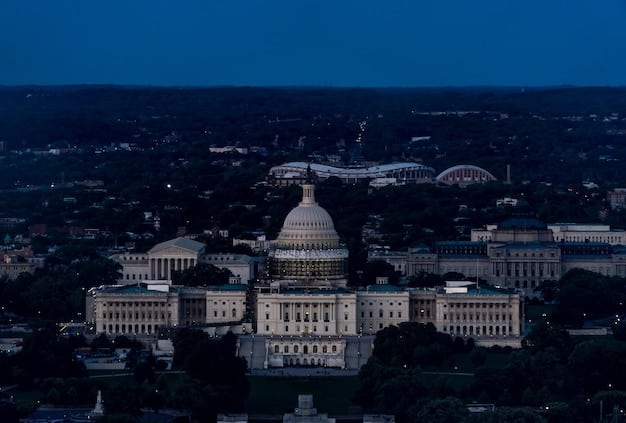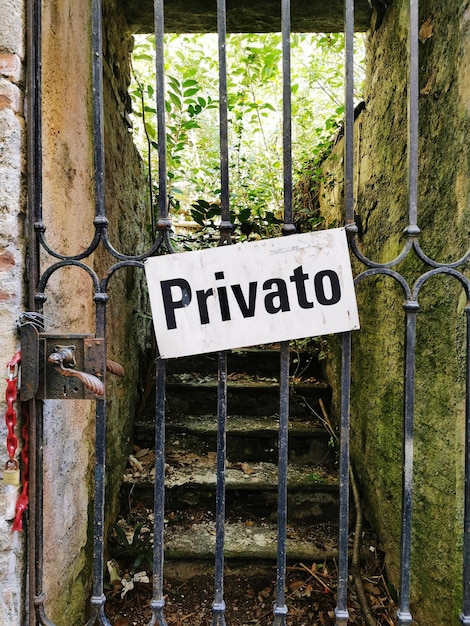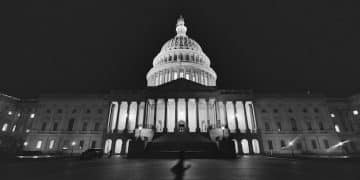Government Shutdown Looms: Impact on US Essential Services

A potential government shutdown in the US threatens to disrupt essential services, affecting everything from national parks and food safety inspections to air travel and federal law enforcement.
An alert: potential government shutdown looms – how will this affect essential services across the US? This question is on the minds of many Americans as political gridlock threatens to halt government operations potentially. Understanding the scope and impact of a shutdown is crucial. Let’s explore what essential services are at risk and how it might impact daily lives.
Understanding a Government Shutdown
A government shutdown occurs when Congress fails to pass appropriation bills funding the government, or the President refuses to sign such legislation into law. This leads to a temporary cessation of operations in many federal agencies. It’s critical to understand the mechanics of how this happens and what specific functions are considered non-essential.
What Triggers a Shutdown?
The US government operates on a fiscal year that begins October 1st. If Congress doesn’t approve a budget or continuing resolutions to extend funding by this date, a shutdown occurs. Disagreements between the House, Senate, and the President on spending levels and policy riders often lead to these funding gaps.
Essential vs. Non-Essential Services
During a shutdown, essential services, deemed necessary for the protection of life and property, continue to operate. These include national security, law enforcement, and emergency medical care. Non-essential services, such as national parks, passport processing, and some regulatory functions, are typically suspended.
- National Security: Active military personnel and essential defense operations remain operational.
- Law Enforcement: Federal law enforcement agencies like the FBI and border patrol continue their duties.
- Emergency Services: Emergency medical care and disaster relief efforts are maintained.
- Air Traffic Control: Air traffic controllers and aviation safety personnel continue working.
Understanding the distinction between essential and non-essential is crucial for gauging the potential impact of a shutdown on various aspects of American life. This distinction dictates which services will continue uninterrupted and which will face temporary suspension.
Impact on National Parks and Recreation
One of the most visible impacts of a government shutdown is the closure of national parks and recreational areas. These closures affect tourism, local economies, and public access to natural resources. The ripple effects extend beyond mere inconvenience, touching on both economic and emotional aspects of the American landscape.

Past shutdowns have shown that the National Park Service (NPS) typically closes parks, monuments, and historical sites. This means no hiking, camping, or access to visitor centers.
Economic Consequences
The closure of national parks can significantly impact local economies that depend on tourist revenue. Hotels, restaurants, and other businesses that cater to park visitors often experience a sharp decline in business during a shutdown.
- Loss of Revenue: Local businesses near national parks face decreased sales and potential layoffs.
- Tourism Decline: Visitors cancel trips, reducing the overall economic activity in the region.
- Impact on Jobs: Park employees and related tourism jobs are temporarily suspended.
Beyond the economic impact, the closure of national parks also affects the public’s ability to enjoy and access these natural treasures. Many Americans plan their vacations around visiting national parks, and a shutdown can disrupt these plans.
Ultimately, the shutdown of national parks serves as a visible reminder of the tangible effects of political gridlock. It highlights the interconnectedness of government services, local economies, and the public’s access to recreational resources.
Effects on Food Safety and Inspections
A government shutdown can also compromise food safety and inspections. Agencies responsible for ensuring the safety of our food supply may be forced to scale back their operations, leading to potential risks for consumers. This is a critical area where reduced government oversight can have immediate and far-reaching effects.
Reduced Inspections
Agencies like the Food and Drug Administration (FDA) and the Department of Agriculture (USDA) are responsible for inspecting food processing facilities and ensuring that food products meet safety standards. During a shutdown, the frequency of these inspections can be reduced, increasing the risk of contaminated food reaching consumers.
Potential Health Risks
With fewer inspections, there’s a higher chance of foodborne illnesses going undetected. This can lead to outbreaks of diseases and other health problems that could have been prevented with proper oversight. The consequences can be severe, particularly for vulnerable populations such as children, the elderly, and individuals with compromised immune systems.
- Increased Contamination Risk: Reduced inspections increase the likelihood of contaminated food products.
- Delayed Recalls: Shutdowns can delay the recall of unsafe food products, prolonging the risk to consumers.
- Impact on International Trade: Reduced inspections can affect the export of US food products, impacting international trade relationships.
Maintaining robust food safety and inspection systems is vital for protecting public health and ensuring consumer confidence in the safety of the food supply. A government shutdown can undermine these efforts and create unnecessary risks.
Delays in Air Travel and Transportation
Air travel can also be significantly affected by a government shutdown. Transportation Security Administration (TSA) and Federal Aviation Administration (FAA) employees are considered essential, but they may be required to work without pay during a shutdown, leading to potential delays and disruptions.
While air traffic controllers are considered essential, the strain of working without pay can lead to decreased morale and potential staffing shortages. TSA agents, responsible for screening passengers and luggage, also face similar challenges.
TSA and Airport Security
TSA agents working without pay may experience increased stress and decreased motivation, potentially leading to longer security lines and increased wait times at airports. This can disrupt travel plans and cause inconvenience for passengers.
FAA and Air Traffic Control
Air traffic controllers working under pressure without pay can face increased stress, which could affect their performance. Though safety protocols are in place, reduced staffing and heightened stress levels can increase the risk of errors and delays.
- Longer Security Lines: Reduced staffing and morale can lead to longer wait times at airport security checkpoints.
- Potential Delays: Air traffic control disruptions can cause flight delays and cancellations.
- Impact on Tourism: Travel disruptions can negatively impact the tourism industry and related businesses.
Ensuring the stability and effectiveness of air travel and transportation systems is crucial for maintaining economic activity and facilitating travel for both business and leisure. A government shutdown can create unnecessary stress and disruptions in these vital areas.
Impact on Federal Employees and Contractors
A government shutdown directly affects federal employees and contractors, who may face furloughs or work without pay. The financial and emotional toll on these individuals and their families can be significant. Understanding their situation is crucial for grasping the full human impact of a shutdown.

Furloughs and Unpaid Work
Many federal employees are placed on furlough during a shutdown, meaning they are temporarily laid off without pay. Those deemed essential may be required to work without pay until the shutdown ends. This creates financial uncertainty and hardship for these workers.
Financial Strain
The financial impact of a shutdown can be severe for federal employees and contractors. Many live paycheck to paycheck and may struggle to pay bills, rent, or mortgages. The stress and uncertainty can also take a toll on their mental and physical health.
- Delayed Paychecks: Federal employees may not receive their paychecks on time, leading to financial difficulties.
- Impact on Benefits: Shutdowns can affect access to benefits such as healthcare and retirement contributions.
- Contractor Uncertainty: Government contractors may face project delays or cancellations, affecting their income and job security.
Recognizing the human impact of a government shutdown is essential for understanding the broader consequences of political gridlock. The stress and uncertainty faced by federal employees and contractors affect not only their families but also the efficiency and effectiveness of government services.
Long-Term Economic and Social Consequences
Beyond the immediate disruptions, a government shutdown can have long-term economic and social consequences. These can range from decreased consumer confidence to damaged international relations. Assessing these broader effects is essential for understanding the full scope of the impact.
Decreased Consumer Confidence
A government shutdown can erode consumer confidence as people become concerned about the stability of the economy. This can lead to reduced spending and investment, slowing economic growth.
Damaged International Relations
Shutdowns can also damage the United States’ reputation on the international stage. They can disrupt diplomatic efforts and undermine trust with allies and partners.
Delayed Government Projects
Many government projects are put on hold during a shutdown, leading to delays and increased costs. This can affect infrastructure development, scientific research, and other important initiatives.
- Economic Slowdown: Reduced government spending and decreased consumer confidence can slow economic growth.
- Impact on Investments: Uncertainty caused by shutdowns can discourage investment and innovation.
- Erosion of Trust: Frequent shutdowns can erode public trust in government and political institutions.
Addressing the root causes of government shutdowns and finding ways to avoid them is crucial for ensuring long-term economic stability and social well-being. Political cooperation and responsible governance are essential for preventing these disruptions and maintaining public trust.
| Key Point | Brief Description |
|---|---|
| 🚨 Shutdown Trigger | Failure to pass budget by Oct 1, leading to halted non-essential services. |
| 🏞️ Park Closures | National parks close, impacting tourism and local economies. |
| ✈️ Travel Delays | TSA and air traffic control face strain, potentially causing delays. |
| 🍔 Food Safety | Reduced inspections increase risk of contaminated food reaching consumers. |
Frequently Asked Questions
▼
A government shutdown occurs when Congress fails to pass, and the President fails to sign, appropriation bills to fund the government’s operations.
▼
Essential services include national security, law enforcement, emergency medical care, and air traffic control. These are deemed necessary to protect life and property.
▼
National parks typically close during a shutdown, leading to a loss of tourist revenue for local economies and limiting public access to recreational areas.
▼
Many federal employees are placed on furlough, meaning they are temporarily laid off without pay. Essential employees may be required to work without pay.
▼
Yes, shutdowns can lead to longer security lines and potential flight delays as TSA agents and air traffic controllers face strain from working without pay.
Conclusion
In conclusion, a potential government shutdown poses significant risks to essential services across the US. From compromising food safety and national parks to disrupting air travel and impacting federal employees, the effects are far-reaching. It underscores the importance of stable governance and the need for proactive measures to avert such crises, ensuring the well-being and security of all citizens.





